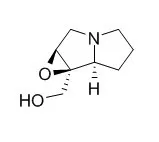METHODS AND RESULTS:
In pyrrolizidine alkaloid-bearing Heliotropium angiospermum and H. indicum shoots exposed, in the light, to (14)C-labeled CO(2) for 44 hours, the incorporation of (14)C into
1,2-Epoxy-1-hydroxymethylpyrrolizidine and retronecine amounted to 0.23 and 0.15%, respectively, of the total carbon assimilated. Treatment of the shoots with alpha-dl-difluoromethylornithine, the specific ornithine decarboxylase inhibitor, at 1 to 2 millimolar had no effect on (14)C incorporation into the necines. In contrast, alpha-dl-difluoromethylarginine, the specific arginine decarboxylase inhibitor, prevented the incorporation of (14)C into the necines of both species; the inhibitor did not affect the absolute incorporation of (14)C from exogenous [1,4-(14)C] putrescine in either species.
CONCLUSIONS:
Thus, arginine is the only apparent endogenous precursor of the putrescine channeled into pyrrolizidines, at least in these two Heliotropium species that exhibited a relatively much higher in vitro activity of arginine decarboxylase than of ornithine decarboxylase. However, within 28 hours after administration, not only exogenous l-[5-(14)C]arginine, but also exogenous l-[5-(14)C]ornithine exhibited significant incorporation of their label into the necines, incorporation that could be partially prevented by both inhibitors. Neither inhibitor affected the rates of (14)C-labeled CO(2) assimilation, transformation of labeled assimilates into ethanol-insoluble compounds, or the very high degree of conversion of the introduced amino acids into other compounds. Methodology related to alkaloid biosynthetic studies is discussed. |






 Cell. 2018 Jan 11;172(1-2):249-261.e12. doi: 10.1016/j.cell.2017.12.019.IF=36.216(2019)
Cell. 2018 Jan 11;172(1-2):249-261.e12. doi: 10.1016/j.cell.2017.12.019.IF=36.216(2019) Cell Metab. 2020 Mar 3;31(3):534-548.e5. doi: 10.1016/j.cmet.2020.01.002.IF=22.415(2019)
Cell Metab. 2020 Mar 3;31(3):534-548.e5. doi: 10.1016/j.cmet.2020.01.002.IF=22.415(2019) Mol Cell. 2017 Nov 16;68(4):673-685.e6. doi: 10.1016/j.molcel.2017.10.022.IF=14.548(2019)
Mol Cell. 2017 Nov 16;68(4):673-685.e6. doi: 10.1016/j.molcel.2017.10.022.IF=14.548(2019)